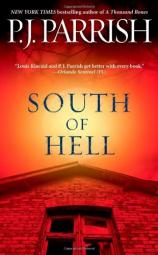South of Hell
Review
South of Hell
P. J. Parrish is the collaborative name of two sisters, Kristy
Montee and Kelly Nichols, who publish a seamless series of novels
set in the 1980s that concern private investigator Louis Kincaid
and his love interest, a former rookie policewoman and now
detective Joe Frye.
SOUTH OF HELL, the latest installment in this superlative
series, contains all of the elements that have made these books a
commanding and addicting reading experience almost from their
inception. Kincaid is an ex-Michigan cop, a golden boy who
experienced a sudden and dramatic fall from grace and who now finds
himself making ends meet, if barely, as a South Florida private
detective. Frye, on the other hand, is on an upward career
trajectory, employed in northern Michigan and planning a run for
the sheriff’s office. The two of them make an unlikely
couple: she’s white, he’s of mixed race; she’s
squared away, he’s not; and both are, each relative to the
other, geographically undesirable. They have so many rough edges
that it’s inevitable someone gets cut, and often. Rough
edges, however, also provide stimulation, and Parrish, with subtle
revelation, communicates the unspoken attraction between the couple
as well.
Kincaid is beginning to feel somewhat prickly over the fact that
he has not heard from Frye for several days. When he eventually
receives a call from Michigan, it is not from Frye but from Jake
Shockey, a middle-aged police detective. Shockey wants Kincaid to
come up to Ann Arbor to assist him in reopening an old missing
person case. Kincaid handled the initial investigation, though his
memory of doing so is next to none. His education at the university
in Ann Arbor ended in disappointment, his career in law enforcement
terminated in bitterness, and he is considered to be
“toxic.” And, as we come to learn, he has a secret
buried in the past that is a source of sharp if silent shame to
him. Still, a trip there will bring Kincaid closer to Frye.
Hoping to fill time as well as salvage the relationship, Kincaid
returns only to almost immediately regret it. Shockey, though not
broken, is so badly bent as to make little difference between the
two. The case he would like to reopen is that of Jean Brandt, with
whom he was involved at the time of her disappearance. Her husband,
Owen, who has since been imprisoned for assaulting another woman,
is about to be released. Shockey is convinced that Owen murdered
his wife and hid the body, perhaps on his ramshackle farm. He wants
Kincaid to assist him in tampering with evidence in the case. A
horrified Kincaid refuses but reluctantly agrees to help him revive
the investigation.
Assisted by Frye in a non-official capacity, Kincaid conducts a
search of Brandt’s abandoned farm --- located, ironically,
just south of hell --- only to find a young woman hiding in the
decrepit house. It develops that the girl, unknown to
Shockey, is Amy, Jean’s daughter. Amy is close to feral
as the result of a number of factors, not the least of which is her
having borne witness to a series of violent events that are locked
deep within her mind. Meanwhile, Owen, a terrifying, violent force
housed in a waste of skin, is released from prison, hell bent on
returning to and acquiring what he considers to be his, as well as
finding out once and for all what happened to Jean. Kincaid,
Shockey and Owen are soon on a collision course that results in a
resolution, but one paid with violent and bloody coin.
The events set forth in SOUTH OF HELL mark a significant turning
point for Kincaid, as he is forced to make one of those choices
that will change his life, perhaps forever. In the course of
solving one mystery from his past, Kincaid must confront, quite
dramatically, the aftershock of his own past actions. There is also
a bit of neat contrast here, a very subtle comparison of how two
men react quite differently to similar revelations. In addition,
the book introduces a couple of new characters, of whom we will
almost certainly see more.
SOUTH OF HELL ultimately explores the extremes of human
behavior, and many of the points in between, through a stark and
unflinching point of view that is nonetheless tempered with the
promise and fulfillment of redemption.
Reviewed by Joe Hartlaub on January 23, 2011





